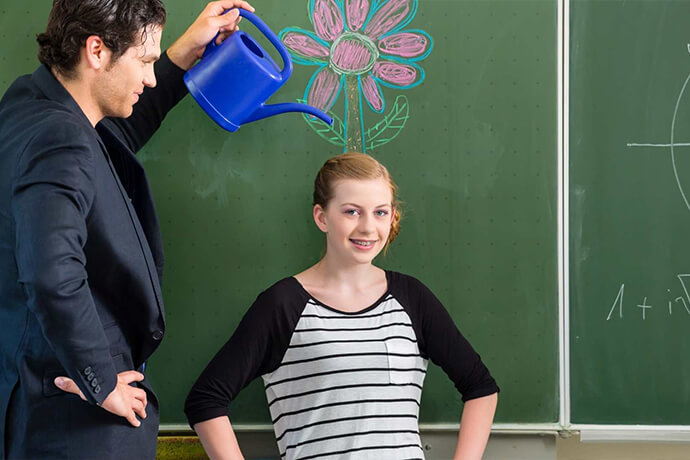 SPEAKERS
SPEAKERS
 TOPICS
TOPICS
People who become lifelong learners are those who are motivated to learn. A lot of this motivation towards learning stem from how they were taught in the classroom as students.

People who become lifelong learners are those who are motivated to learn. A lot of this motivation towards learning stem from how they were taught in the classroom as students. A good teacher knows how to inspire their students to pick up their text books. They help build driven students who are curious about the world.
Even though teachers would love for their students to be motivated all the time, this is hardly ever the case. So what do you do if your students aren't motivated enough? How do you inspire them and ensure that they stay inspired?
There are two kinds of motivation that you can use to enthuse your students- intrinsic and extrinsic motivation.
If you want to know how to motivate students in the classroom, then the first thing that you need to know is understand what motivation is. This will help you learn how to inspire students as a teacher. Activities that lead a person towards their goal are started by their motivation. It's also their motivation that helps them put in sustained effort to reach their goals.
Motivational processes can be personal or internal influences, which affect external behavior. This is through choices, dedication and effort. There are two kinds of motivation that you should know about:
Intrinsic Motivation
This kind of motivation is internal to the person. Consider a student who want to learn a foreign language and do well in their tests, simply because they are interested in culture of the foreign land. For them, it's their interests and enjoyment that gives them motivation. People with higher intrinsic motivation are better performers and achieve greater things in life.
Extrinsic Motivation
Extrinsic motivation on the other hand, is the kind of motivation that was derived from an external source, such as an incentive or a reward. Take for example students who study a foreign language to get a tangible reward, like working in the country whose language they are learning.
Their rewards can include approvals from others as well. Students who want to do well in their exams to please their parents or teachers fall under this category.
Learn how to improve student motivation through this guide.

There are several ways to motivate students in the classroom. The self-determination theory states that there are three psychological needs that are fundamental when it comes to motivation. These include autonomy, relatedness and competence.
The autonomy of the student is the initiative they take when it comes to their learning. This is where students are involved in the decision-making processes regarding their education. Blended learning, which combines classroom learning with self-study, can generate autonomy. Students should be taught about accountability and how they are responsible for their successes and failures.
When it comes to competence, students should be made to feel like they have what it takes to grow. This is why teachers need to help students develop their self-esteem. Students should be taught how to have a growth mindset, and why this can help them.
Relatedness refers to whether the students feel like they belong in the classroom or not. By establishing relationships with students, you can make them feel more motivated about coming to class. Encourage peer connections by using team-building activities within the class. This guide teaches you how to motivate students.

Student motivation activities can help teachers build a positive learning environment in the classroom. Juggling teaching your subject with motivating students can seem hard. Here are several ways that teachers can motivate their students to perform better:
1. Building Relationships
Motivational teachers often have strong relationships with their students. From the time the student enters school, they need to start developing quality relationships. Interpersonal relationships in school play an important role in developing the personality of the student. It can positively affect their future. Building relationships with students and encouraging relationships between them can help students feel more motivated.
2. Learning Environment
You can change the classroom environment to motivate students as well. Ask students to sit in single file rows or choose another form of flexible seating. When the students feel more comfortable in their learning space will engage with you more and retain more information. You can add things like pillows, stools, rocking chairs, bouncing chairs, and more to the classroom. This will help the students feel more at ease and ready to learn.
3. Involve Parents
Student engagement strategies don't always mention involving parents, but this can be an important step. Parents can help motivate their children to do better. Consider creating a weekly newsletter with your class, that gets sent to the parents at the end of every week.
This way, parents know what's happening at school. Don't just call parents when you have some negative news, but let them know positive news as well.
4. Use Relevant Materials
Motivating students to learn can be hard. Consider explaining to them the relevance of the material you are teaching them from. Tell them why the material is important and how it can help your students. Show them the real-world applications of what you're teaching them.
5. Student-Centric Teaching
Student motivation tips often mention that your approach to teaching should be student-centric, if you want to teach more effectively. An approach centered on the students helps students stay engaged through the process of learning. In a teacher-centric approach on the other hand, the teacher is simply responsible for delivering information without engaging the student. Ask your students to express what they understand from the information you provide.
6. Collaborative Learning
A very useful student motivation strategy that you can use is collaborative learning. There are not just motivational but also cognitive benefits to this. Create tasks for groups of students and ask them to work together on the project. Create opportunities for all the group members to contribute. You can also assign students with partners, who you think they might be able to learn from.
Fostering classroom motivation is easier when the students are working with each other.
Motivating students to be better learners is a lot easier when you know what motivation is and how it affects learning capabilities. This guide teaches you not just about motivation, but also shows you how implement strategies that help your students feel more motivated. From collaborative learning to building relationships with students, use the tips in this guide to start motivating your students.
Speaker Agency can connect you to speakers who can teach you more about building motivation in students and inspiring them to work better. Get in touch with Speaker Agency to find out how you can learn more about motivation from the best in the industry.